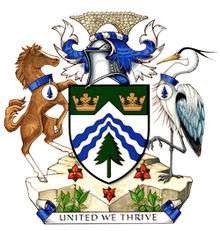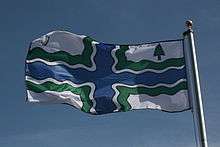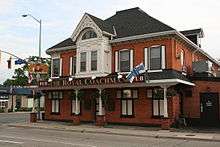Flamborough, Ontario
Flamborough (sometimes both officially and informally spelled Flamboro) is a former town near, and a current community in, Hamilton, Ontario, Canada. For most of its existence before amalgamation with Hamilton in 2001, Flamborough comprised the former townships of East Flamborough, West Flamborough, and Beverly, as well as the Village of Waterdown. The largest suburban community is the former Village of Waterdown containing perhaps one third of its thirty thousand or so inhabitants. Other Flamborough communities include: Carlisle, Christie's Corners, Clappison's Corners, Copetown, Freelton, Greensville, Lynden, Kirkwall, Millgrove, Mountsberg, Orkney, Rockton, Troy, Sheffield, Valens, and Westover.
History
The area has a long history of human occupation. There is evidence in the immediate area of Paleo-Indian occupation. Later, the area was inhabited by the aboriginal people known variously as the Neutral or Attawandaron until they were annihilated by the Iroquois nations from what is now New York State. The first recorded visit to the area by Europeans was on September 24, 1669, when the French explorers La Salle and Joliet met near Tinawatawa, now Westover. When New France was conquered by the British in 1763, the territory became part of the British Empire.
After the American Revolution in 1783 and the creation of Upper Canada, land at the western end of Lake Ontario was surveyed and organized into townships, which included East Flamborough, West Flamborough and Beverly. Governor's Road (also known as Queen's Highway 99 and later Regional Roads 399 and 299) was built on the border with neighbouring Ancaster Township in 1794–95, linking York (later Toronto) and London.
The three townships and Village of Waterdown were founding constituents of Wentworth County in 1816. The Village of Waterdown was created in 1879 from that part of East Flamborough above the Niagara Escarpment and within approximately a kilometre of King's Highway No. 5 (Dundas Street). The Town of Dundas was created from parts of West Flamborough and Ancaster Townships.
Lionel Beaumaurice "Leo" Clarke was born near Waterdown in 1892, and his family left for Winnipeg, Manitoba, in 1903. During the First World War, he enlisted in the Canadian Expeditionary Force and fought in France. On September 9, 1916, during the Battle of Somme, Corporal L.B. Clarke single-handedly repulsed a German attack. Unfortunately, he was killed in combat on October 19, 1916 before he could receive his Victoria Cross.
Flamborough flag and coat of arms


On April 15, 2011, the Chief Herald of Canada (exercising the Royal Prerogative) granted arms, as well as a flag, to The Waterdown-East Flamborough Heritage Society that would reflect the historical Town of Flamborough. It is intended that these arms are to be used by the residents of Flamborough (including Beverly) to honour their history and identity. The arms and flag were presented to the community on April 29, 2011, by the Right Reverend Bishop Ralph Spence, Albion Herald Extraoridinary, at the Carlisle Golf & Country Club.[1]
The newsletter of The Waterdown East Flamborough Heritage Society explained in its April 2011 edition:
Arms and flags have a long history in this country, and are important tools used to project identity. Often a community's flag and coat of arms are residents' only reminders of their area's rich history. It was with this idea in mind that a grant of arms committee was struck by the WEFHS in 2009.
Comprised of members from every corner of the historic Flamborough-Beverly region, the committee worked closely with the Canadian Heraldic Authority (and in particular Dr. Forrest Pass, the Herald assigned to the file) to create a symbol that reflected our unique corner of the world, including both its human and natural aspects. After their first gathering in the Dart Room of the Royal Coachman, meetings were held in Rockton, Greensville, Waterdown, Carlisle, Clappisons Corners, Strabane, and Clyde as various symbols were hotly debated. Historic township seals were consulted, as well as previous symbols of the Town of Flamborough. In creating a motto for the community, every school in the area (over 20) were consulted and students were asked to send in their suggestions.[2]
On May 10, 2011, the Flamborough flag was raised over Waterdown District High School in the presence of its student body, as well as a delegation from Allan A. Greenleaf Public School.[3]


Government
In 1974, Flamborough Township was created by amalgamating the townships of East Flamborough, West Flamborough, Beverly with the Village of Waterdown. At the same time, a small portion of Beverly Township near the community of Clyde was ceded to North Dumfries Township and a more populous but smaller portion of East Flamborough near the community of Aldershot was ceded to Burlington. Flamborough became a town in 1985.
In 2001, the provincial government amalgamated Flamborough with Ancaster, Dundas, Glanbrook, Stoney Creek and Hamilton into the City of Hamilton.
The amalgamation was bitterly and unsuccessfully protested by some Flamborough residents and those of adjacent communities, particularly since the incumbent Progressive Conservative MPP, Toni Skarica's government had promised in the previous election that the amalgamation would not occur. Skarica resigned in protest, but the amalgamation was not rescinded.
The population of Flamborough at the 2001 census was 37,796. By the 2006 census, its population had increased to 39,220.
Geography and natural attractions
Much of Flamborough is located on top of the Niagara Escarpment; thus the Bruce Trail passes through the area. Although relatively flat in the south, a slow but steady incline is observable until reaching the Wellington County line which is the approximate height of land dividing two watersheds. The Beverly Swamp, located in the western part of the former Beverly Township, is another important physiographic area.
Notable natural attractions operated by the Hamilton Conservation Authority include:
- Westfield Heritage Centre, a living history museum containing pioneer era buildings moved from other locations across Ontario
- Valens Conservation Area, offering camping and boating at its reservoir[4]
- Christie Lake, swimming and stocked fishing at its reservoir[5]
- Spencer Gorge and Webster's Falls Conservation Area, spectacular view of the falls and city below while hiking on the Bruce Trail.
Economy and commercial attractions
After early European settlers had cleared the land of pine and oak forests, they began subsistence and then export farming. Disregarding the swamp and the excessively rocky areas of the Mountsberg area, the land is devoted chiefly to agriculture. Much of the arable land is devoted to raising corn, strawberries and cash crops.
In recent decades, Flamborough has become home to commuters and hobby farmers in the Golden Horseshoe. It has easy access to secondary highways, especially with the opening of an interchange with Highway 403 at Waterdown Road, granting easier access for traffic to/from Toronto.[6]
Notable attractions operated as commercial enterprises include:
- Flamboro Downs, featuring harness racing, and slot machines
- Flamboro Speedway, featuring car racing
- African Lion Safari, with land mammals and birds of prey in an open air zoo
- Rockton World's Fair, an agricultural exhibition held every Thanksgiving Weekend (Canadian)
Gallery
-
Freelton Farmhouse
-
Carlisle
-
Anglican Christ Church
-
Farmhouse
-
Christie Lake
-
Clapinson's Corners
-
Copetown
-
Farms in Flamborough
-
Freelton
-
Greensville
-
Greensville
-
Millgrove
-
Millgrove, Millgrove General Store
-
Farm in Flamborough
-
Freelton, Roman Catholic Church
See also
References
- ↑ Cornish, Dianne. "Flamborough’s coat of arms unveiled". Flamborough Review. Retrieved 6 August 2011.
- ↑ Tidridge, Nathan. "Mr." (PDF). The Waterdown East Flamborough Heritage Society. Retrieved 7 August 2011.
- ↑ Tidridge, Nathan. "Mr. Tidridge's Website". WDHS. Retrieved 6 August 2011.
- ↑ Valens Conservation Area
- ↑ Christie Lake
- ↑ http://cms.burlington.ca/Page5487.aspx
External links
| Wikimedia Commons has media related to Flamborough, Ontario. |
- Rockton World's Fair
- Flamborough Information and Community Services
- Scouts Canada - 1st Carlisle Group
- 3rd Waterdown Scouting
- Dufferin Masonic Lodge No. 291 A.F. & A.M.
- Waterdown Ontario Online - Waterdown & Flamborough Community Website
Coordinates: 43°20′46″N 80°03′18″W / 43.346°N 80.055°W